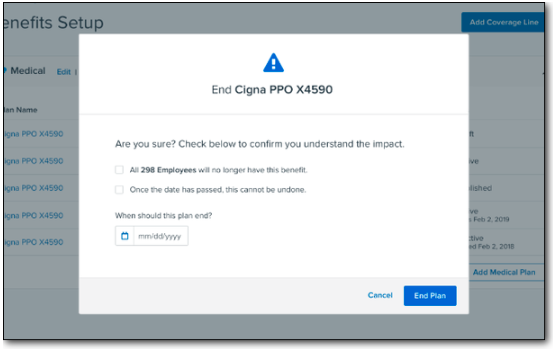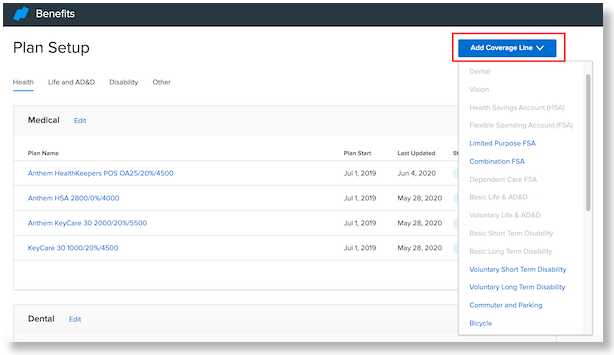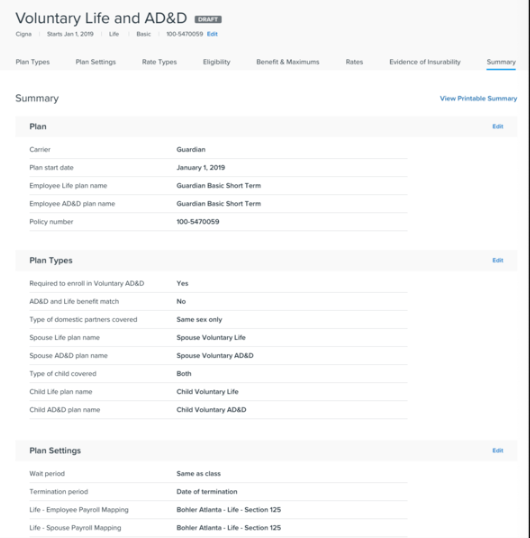Plan Setup Assistant: Life and AD&D
How to configure your company's life and AD&D coverage in the benefits setup assistant.
ACCESSING LIFE AND AD&D
To access disability benefits configuration, click Manage Benefits on the Namely homepage.
Benefits Setup
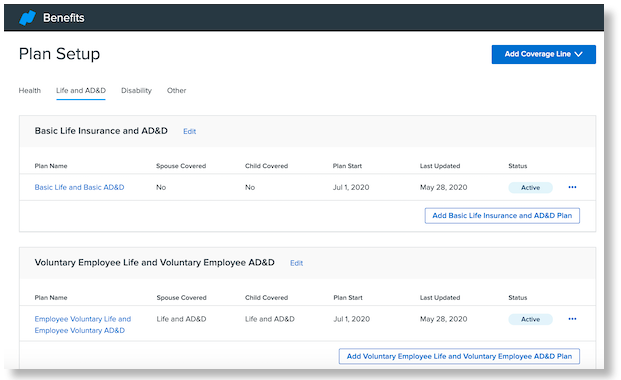
On the Benefits Setup page, you can view your past, current, and future benefits plans. Click Life and AD&D to view your life and AD&D plans once they have been configured.
TIP:
Only active plans will migrate to Enrollment Setup > Plans and be available for employee enrollment. Draft plans will only appear in the setup assistant.
ADDING A COVERAGE LINE
To add a Coverage Line:
-
Click Add Coverage Line.
-
Choose the type of coverage line from the dropdown menu.
-
You can select Basic Life and AD&D or Voluntary Life and AD&D.
-
COVERAGE LINES
The coverage line setup assistant asks a series of questions to configure your life and AD&D coverage lines. If you don't offer spousal or child coverage, you can skip those questions. To exit without saving, click Cancel
To start configuring your coverage line settings, enter the coverage line name.
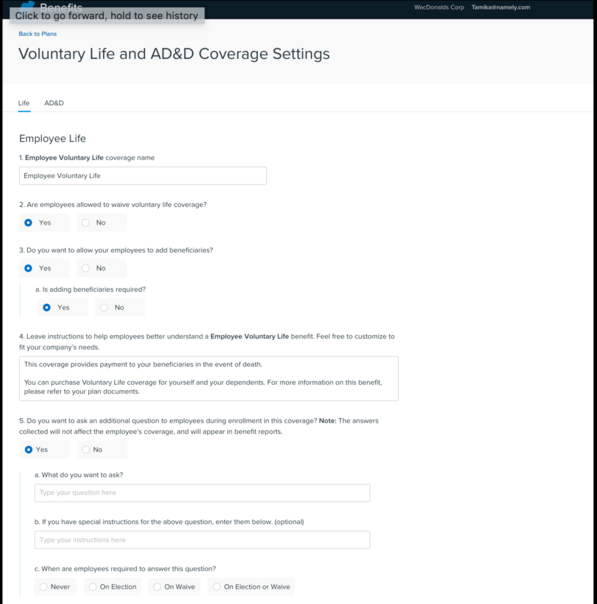
Waiving Coverage and Dependent Rules
-
Select whether employees can waive coverage.
-
Select whether employees are allowed to add beneficiaries.
-
If you select yes, select whether beneficiaries are required.
-
-
If you want to provide instructions to your employees to help them understand their coverage options, you can enter them here.
-
If you want to ask an additional question of your employees, like who their primary care physician is, you can enter it here.
-
If you have any documents about your company’s coverage options, upload them in Enrollment Setup > Plan Documents.
Spouse Life
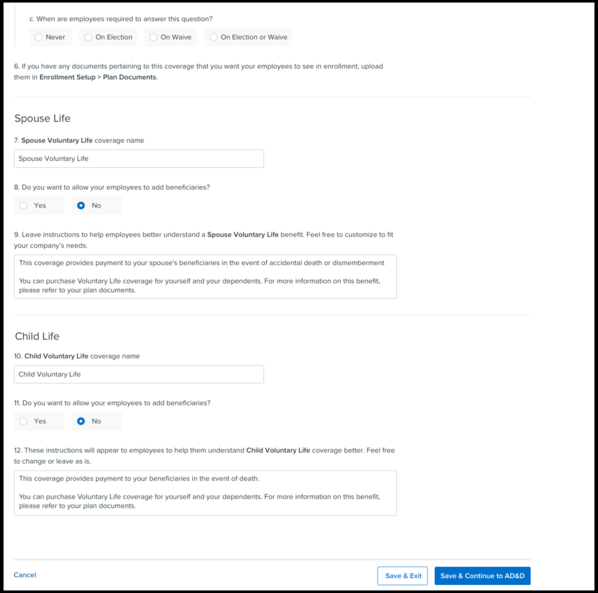
Note: If you are not offering spousal coverage, you can skip this section.
-
Enter the Spouse Voluntary Life coverage name.
-
Select whether the employee can add beneficiaries to the spouse plan.
-
If you want to provide instructions to your employees to help them understand their coverage options, you can enter them here.
Child Life
Note: If you are not offering child coverage, you can skip this section.
-
Enter the Child Voluntary Life coverage name.
-
Select whether the employee can add beneficiaries to the child plan.
-
If you want to provide instructions to your employees to help them understand their coverage options, you can enter them here.
After making any desired changes, click Save and Continue to AD&D.
-
You must complete both the Life and AD&D sections to save the coverage line.
Any required fields that have not been completed will be marked in red. You cannot continue setting up your plans until these fields have been completed.
TIP:
Coverage lines created in the setup assistant won’t map to Enrollment Setup > Coverage Line until you have activated a plan under that coverage line.
CREATING A PLAN
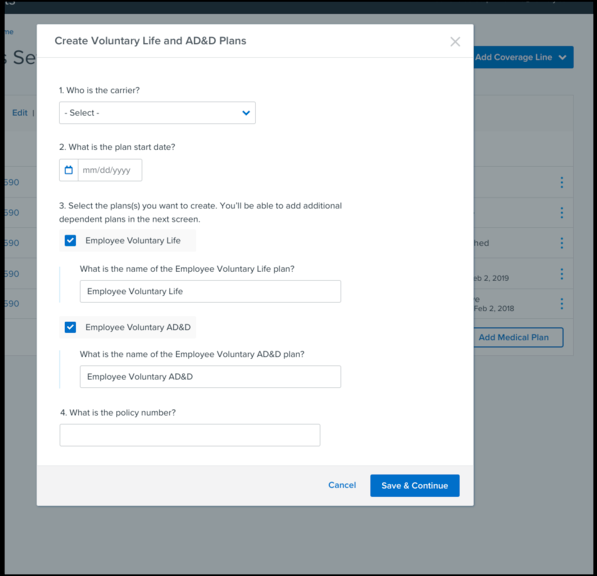
After a coverage line is created, you can create plans for it.
To create a new plan at any time, click Add Voluntary Life and AD&D Plan or Add Basic Life and AD&D Plan the Benefits Setup page.
The plan setup assistant asks a series of questions to configure your plan options. Enter your preferences in the fields provided.
-
Enter the plan carrier.
-
Enter the policy start date.
-
Select whether you want to set up a Life plan, an AD&D plan, or both.
-
Enter the plan name(s).
-
Enter the policy number.
Once you have completed the required fields, click Save and Continue. Note: You can’t save your plan as a draft without completing these fields.
To edit your plan’s carrier, start date, name(s), or policy number, after it has been created, click Edit in the top right corner of the plan setup assistant.
PLAN TYPES
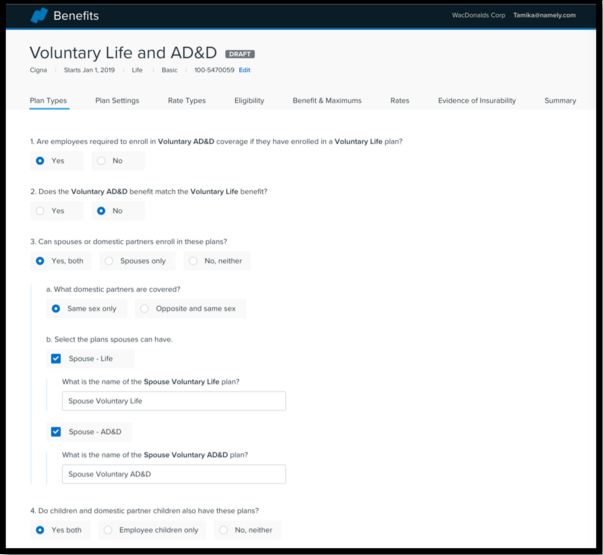
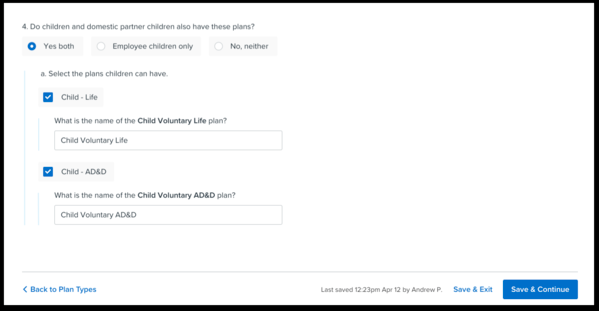
On the Plan Types page, you can define the relationship between your life and AD&D plans, as well as spousal and child coverage. If you aren't setting up both life and AD&D plans, you won't be asked questions 1 and 2.
-
Select whether employees are required to enroll in an AD&D plan if they have enrolled in a life plan.
-
Select whether AD&D benefits match the life benefit.
-
If the benefits match, we will base your AD&D plan structure off the answers provided for your life plan structure.
-
-
Select whether spouses or domestic partners can enroll.
-
If you select yes, select whether only same sex or both opposite and same sex partners are eligible.
-
Select the types and enter the names of the plans spouses and domestic partners can have.
-
-
Select whether children and children of domestic partners can enroll.
-
Select the types and enter the names of the plans children can enroll in.
-
PLAN SETTINGS
Under Plan Settings, you can set your wait and termination periods for the plan and what payroll deduction the plan should map to.
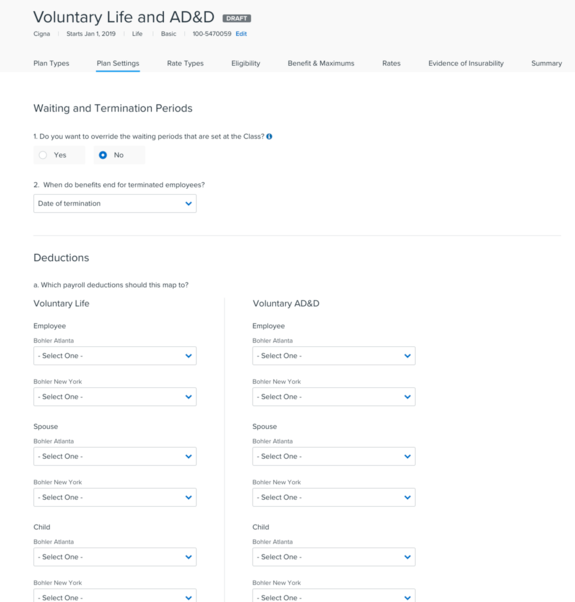
Wait and Termination Periods
Wait periods determine the amount of time an employee has to wait after their hire date before their benefits are effective. Termination periods determine the amount of time an employee’s benefits are effective after they are terminated.
-
Select if you want to override wait periods that are set at the class level.
-
If you override wait periods, use the dropdown menus to specify when you want benefits to start.
-
-
Select when benefits should end for terminated employees.
Deductions
-
Select the payroll deduction(s) the plan should map to.
-
You are required to map deductions for each plan you have elected to set up (Life, AD&D, employee, spouse, and/or child).
-
If you have multiple EINs, each EIN displays in this section to be mapped.
-
After making any desired changes, click Save and Continue.
RATE TYPES
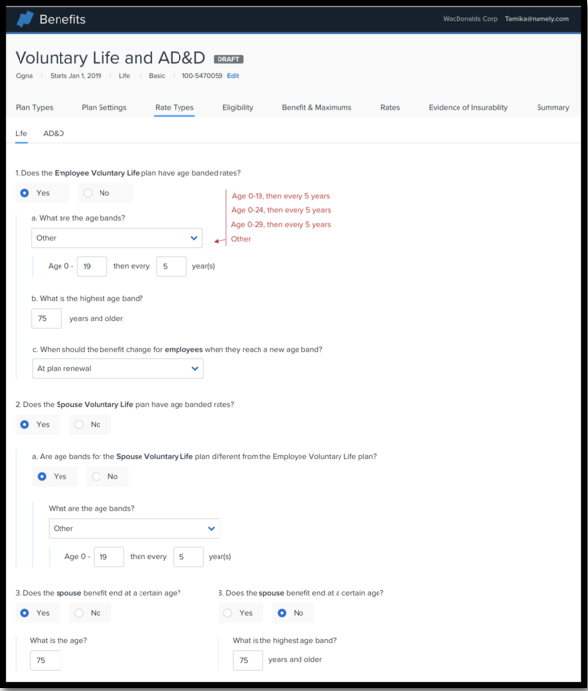
On the Rate Types page, you can set up the structure for your rates for this plan. If you are setting up both life and AD&D coverage and their structures don't match, there will be separate tabs for each type of plan. Additionally, you can define the structure for spouse and child plans, if you are offering them.
-
Select if the plan has different rates based on age. If you select yes:
-
Select what the age bands are. You can select:
-
Age 0-19, then every 5 years
-
Age 0-24, then every 5 years
-
Age 0-29, then every 5 years
-
Other
-
If you select Other, you can set up the initial age band and age increments.
-
-
-
Enter the highest age band.
-
Select when the benefit should change for employees when they reach a new age band.
-
Complete any questions for spousal or child coverage, if applicable.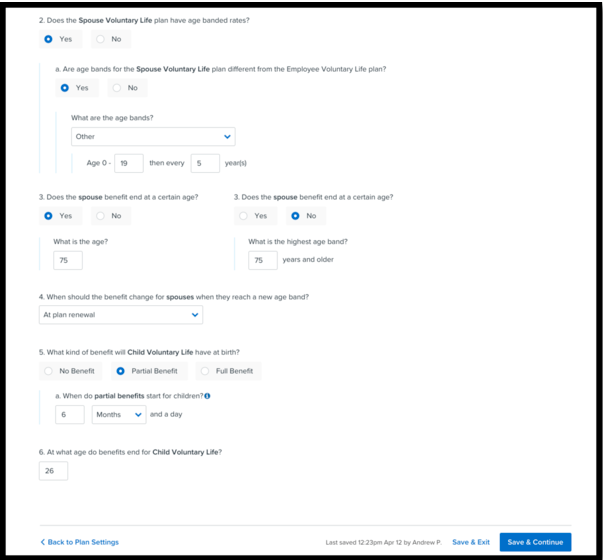
After making any desired changes, click Save and Continue
ELIGIBILITY
If your organization has different plan rates for different employee groups (based on class, branch, division, or a combination of class and branch), you can assign them on the Eligibility page. You can also make employee groups ineligible for your plan.
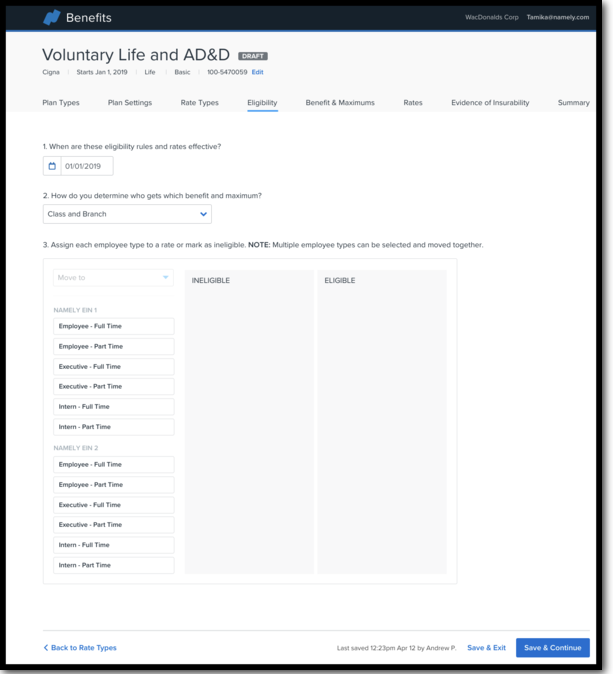
-
Enter when your eligibility rules and rates are effective.
-
Select how you determine who gets which benefit and maximum:
-
By class
-
By branch
-
Bydivision
-
By class and branch
-
-
Select the relevant org unit(s) and use the Move to dropdown to make them eligible or ineligible for the benefit.
-
If you have groups of employees with different benefit amounts, you can create another plan for them.
-
After making any desired changes, click Save and Continue.
BENEFITS AND MAXIMUMS
On the Benefits and Maximums page, you can define the maximum benefit for your life and/or AD&D plans, as well as whether the maximum is based on a multiple of the employee's earnings or as a fixed dollar amount.
-
Note: You must complete the Rate Types and Eligibility sections before you can advance to the Benefits and Maximums page.
Multiple of Employee's Earnings (Voluntary)
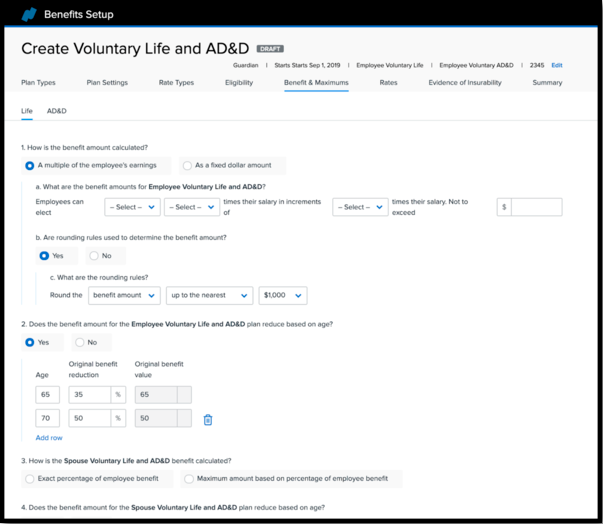
-
Select that the benefit amount is a multiple of the employee's earnings.
-
Enter the benefit multiple and maximum values as defined by your broker or in your plan documents.
-
Select whether rounding rules are used to determine the benefit amount. If you select yes:
-
Enter the rounding rule configuration.
-
-
Select whether the benefit amount reduces based on the employee's age.
-
If you select yes, enter the age as well as the percent reduction of the original benefit amount. You can add as many ages and reductions as needed by clicking Add row.
-
-
If you are setting up spouse coverage, select whether the benefit is calculated as an exact percentage of the employee benefit up to a defined maximum or a maximum amount based on a percentage of the employee benefit.
-
If you are setting up child coverage, select whether the benefit is calculated as flat amounts, a maximum and increments, or an exact percentage of the employee benefit.
-
Flat amounts allow you to enter options for child coverage that do not have increments.
-
Maximum and increments allow you to enter minimum and maximum values and increments employees can chose from to cover their children.
-
Exact percentage of employee benefit up to a defined maximum.
-
If you are setting up both life and AD&D coverage and their structures don't match, there will be separate tabs for each type of plan.
After you have completed all required fields, click Save and Continue.
Fixed Dollar Amount (Voluntary)
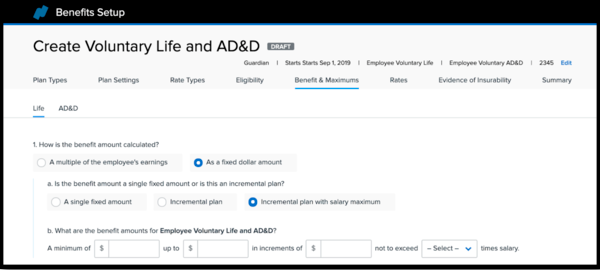
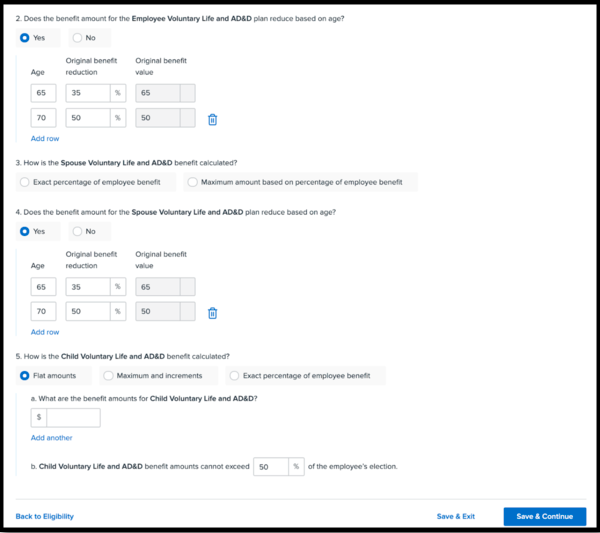
-
Select that the benefit amount is a fixed dollar amount.
-
Select whether the benefit is a single fixed amount, an incremental plan, or an incremental plan with a salary maximum.
-
Complete the required fields based on your selection in question a.
-
-
Select whether the benefit amount reduces based on the employee's age.
-
If you select yes, enter the age as well as the percent reduction of the original benefit amount. You can add as many ages and reductions as needed by clicking Add row.
-
-
If you are setting up spouse coverage, select whether the benefit is calculated as an exact percentage of the employee benefit up to a defined maximum or a maximum amount based on a percentage of the employee benefit.
-
If you are setting up child coverage, select whether the benefit is calculated as flat amounts, a maximum and increments, or an exact percentage of the employee benefit.
-
Flat amounts allow you to enter options for child coverage that do not have increments.
-
Maximum and increments allow you to enter minimum and maximum values and increments employees can chose from to cover their children.
-
Exact percentage of employee benefit up to a defined maximum.
-
If you are setting up both life and AD&D coverage and their structures don't match, there will be separate tabs for each type of plan.
After you have completed all required fields, click Save and Continue.
Multiple of the Employee's Earnings (Basic)
-
Select that the benefit amount is a multiple of the employee's earnings.
-
Enter the benefit multiple and maximum values as defined by your broker or in your plan documents.
-
Select whether rounding rules are used to determine the benefit amount. If you select yes:
-
Enter the rounding rule configuration.
-
-
Select whether the benefit amount reduces based on the employee's age.
-
If you select yes, enter the age as well as the percent reduction of the original benefit amount. You can add as many ages and reductions as needed by clicking Add row.
-
-
If you are setting up spouse coverage, select whether the benefit is calculated as an exact percentage of the employee benefit up to a defined maximum or a maximum amount based on a percentage of the employee benefit.
-
If you are setting up child coverage, select whether the benefit is calculated as flat amounts, a maximum and increments, or an exact percentage of the employee benefit.
-
Flat amounts allow you to enter options for child coverage that do not have increments.
-
Maximum and increments allow you to enter minimum and maximum values and increments employees can chose from to cover their children.
-
Exact percentage of employee benefit up to a defined maximum.
-
If you are setting up both life and AD&D coverage and their structures don't match, there will be separate tabs for each type of plan.
After you have completed all required fields, click Save and Continue
Fixed Dollar Amount (Basic)
-
Select that the benefit amount is a fixed dollar amount.
-
Enter the benefit amount.
-
-
Select whether the benefit amount reduces based on the employee's age.
-
If you select yes, enter the age as well as the percent reduction of the original benefit amount. You can add as many ages and reductions as needed by clicking Add row.
-
-
If you are setting up spouse coverage, select whether the benefit is calculated as an exact percentage of the employee benefit up to a defined maximum or a maximum amount based on a percentage of the employee benefit.
-
If you are setting up child coverage, select whether the benefit is calculated as flat amounts, a maximum and increments, or an exact percentage of the employee benefit.
-
Flat amounts allow you to enter options for child coverage that do not have increments.
-
Maximum and increments allow you to enter minimum and maximum values and increments employees can chose from to cover their children.
-
Exact percentage of employee benefit up to a defined maximum.
-
If you are setting up both life and AD&D coverage and their structures don't match, there will be separate tabs for each type of plan.
After you have completed all required fields, click Save and Continue
RATES (NON-AGE BANDED)
Life
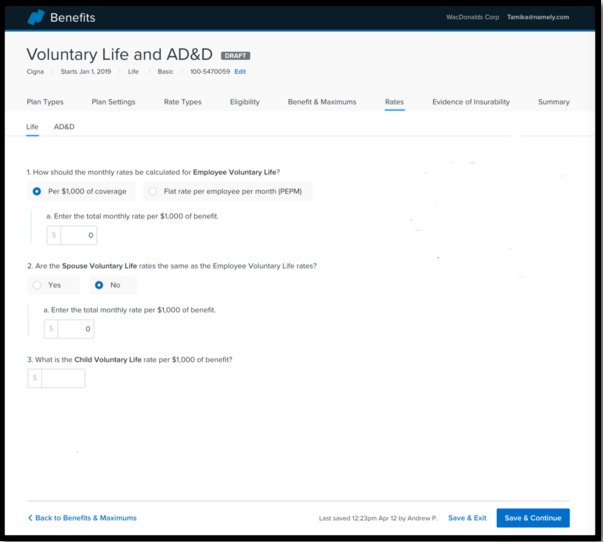
-
Select whether the monthly rate should be calculated per $1,000 of coverage or a flat rate per employee per month.
-
Enter the total monthly rate.
-
-
If you are offering spousal coverage, select whether the rates are the same as the employee rates.
-
If you are offering child coverage, enter the child rate.
AD&D
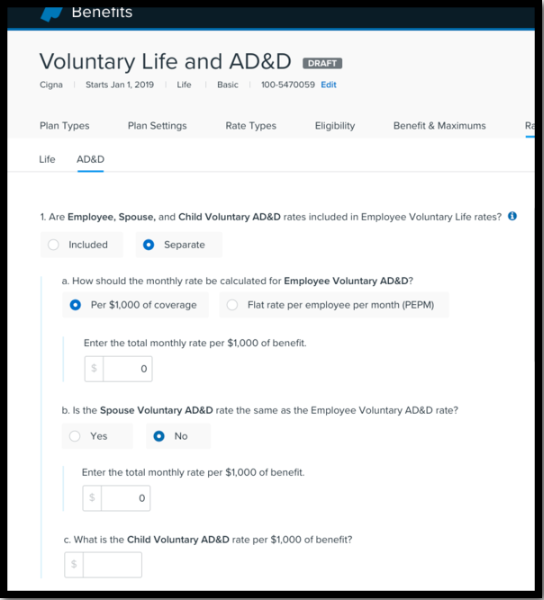
If you are setting up both life and AD&D coverage, they will display in separate tabs. We recommend setting up life and AD&D coverage separately to help expedite claims if an employee needs to file one.
After you have set up your life and AD&D plans, click Save and Continue.
RATES (AGE-BANDED)
-
Select how the monthly rate should be calculated.
-
Enter the total monthly rate per age band.
-
-
If you are setting up spousal coverage, select whether their rates are the same as the employee's.
-
If you select no, enter the spouse monthly rate per age band.
-
-
Select whether spouse rates are based on the employee's age or the spouse's age.
-
If you are setting up child coverage, enter the child rate.
After you have completed all required fields, click Save and Continue.
EVIDENCE OF INSURABILITY
Employees are required to complete an evidence of insurability (EOI) document proving they are in good health if they elect over a certain benefit amount for life or disability. That benefit amount is the guaranteed issue amount. Employees are generally given a guaranteed issue amount the first time they can elect the benefit.
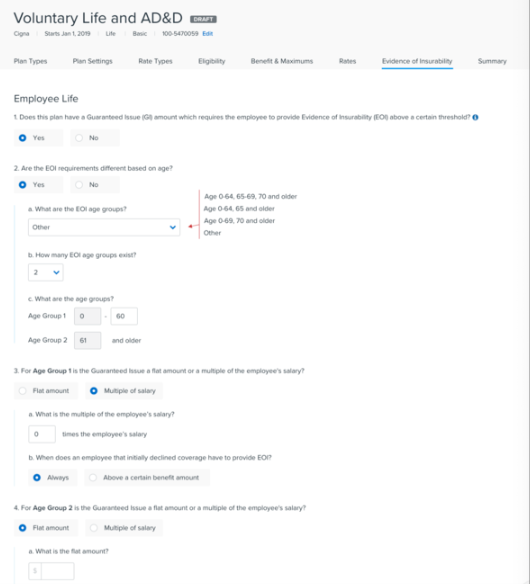
-
Select whether your disability plan has a guaranteed issue amount.
-
If you select yes to question 1, select whether EOI requirements are different based on the employee's age.
-
If you select yes, select the EOI age groups from the dropdown, or select Other to set up your own unique age group configuration.
-
After you have completed setting up your age groups, the remaining EOI questions are asked per age group. The initial EOI and update threshold amounts are asked for each age band, while the late threshold is only asked once and applies to all age groups.
-
-
-
-
Select whether the maximum amount before an EOI is required is a flat dollar amount or a multiple of the employee's salary.
-
Depending on your selection, enter the flat dollar amount or salary multiple.
-
-
Select whether employees already enrolled in this coverage are allowed to increase their benefit without providing an EOI.
-
If you select yes, enter the amount employees can increase by without additional documentation being required.
-
Select what type of life event is required for an employee to qualify.
-
-
Select whether employees who have declined coverage can enroll at a later date without providing an EOI for a certain threshold.
-
If you select Always, employees will be required to submit an EOI for any amount.
-
If you select Above a certain amount, enter the amount above which an EOI is required.
-
If you are setting up coverage for spousal coverage, complete the above questions for the spousal plan.
If you are setting up an AD&D plan, select whether, if a member's life insurance is pending, the AD&D amount will pend until the life amount is approved, or if the full AD&D amount is approved without EOI.
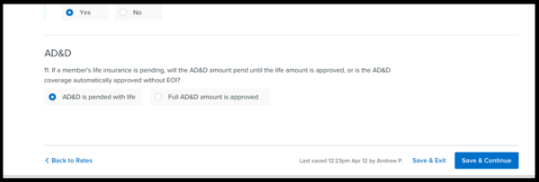
-
For example, I elect $150,000 of life and AD&D coverage, and $100,000 is the guaranteed life issue amount, but $50,000 is pended. If AD&D is pended with life, then $50,000 of AD&D will also pend. If the full AD&D amount is approved, then the full $150,000 AD&D will be approved while only $100,000 of life will approve.
PLAN SUMMARY
On the Plan Summary page, you can review all of the details you have configured for your plan.
Under Rates, you can view the plan rates on a per-pay basis using the dropdown menu.
If any information is incorrect, click Edit next to the section you want to reconfigure.
TIP:
Changing your rate types will remove any rates you have entered.
To save your plan in a draft state without publishing it, click Save and Exit.
To activate your plan and make it available for enrollment on the plan effective date, click Activate Plan.
TIP:
Note: If you have not completed a section or required field, an error displays and you cannot publish your plan until it has been completed.
ENDING AN ACTIVE PLAN
To end a plan:
-
On the Plan Summary page, click End Plan.
-
Confirm that you understand the number of employees who will be affected by this change, and that this action can’t be undone, by clicking the checkboxes.
-
Enter the Plan End Date.
-
Note: If you end a plan, employees won’t be automatically unenrolled from it. Employees will have to be re-enrolled into a new plan, or you can contact Namely for support.
-
-
Click End Plan.
